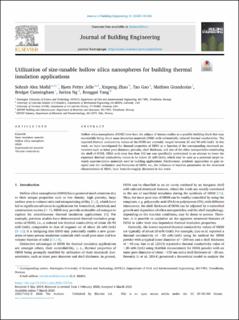| dc.contributor.author | Alex Mofid, Sohrab | |
| dc.contributor.author | Jelle, Bjørn Petter | |
| dc.contributor.author | Zhao, Xinpeng | |
| dc.contributor.author | Gao, Tao | |
| dc.contributor.author | Grandcolas, Mathieu | |
| dc.contributor.author | Cunningham, Bridget | |
| dc.contributor.author | Ng, Serina | |
| dc.contributor.author | Yang, Ronggui | |
| dc.date.accessioned | 2020-03-24T13:57:50Z | |
| dc.date.available | 2020-03-24T13:57:50Z | |
| dc.date.created | 2020-03-09T15:20:09Z | |
| dc.date.issued | 2020 | |
| dc.identifier.citation | Journal of Building Engineering. 2020, 31 1-9. | en_US |
| dc.identifier.issn | 2352-7102 | |
| dc.identifier.uri | https://hdl.handle.net/11250/2648395 | |
| dc.description.abstract | Hollow silica nanospheres (HSNS) have been the subject of intense studies as a possible building block that may successfully bring about nano insulation materials (NIM) with substantially reduced thermal conductivity. The reported thermal conductivity values of the HSNS are currently ranged between 20 and 90 mW/(mK). In this work, we have investigated the thermal properties of HSNS as a function of the corresponding structural pa-rameters such as inner pore diameter, porosity, shell thickness, and size of the silica nanoparticles constituting the shell of HSNS. HSNS with sizes less than 100 nm was specifically synthesized in an attempt to lower the expressed thermal conductivity values to be below 20 mW/(mK), which may be used as a potential target to-wards superinsulation materials used in building applications. Furthermore, synthetic approaches to gain in-sights into the mechanism and formation of HSNS, i.e., the influence of reaction parameters on the structural characteristics of HSNS, have been thoroughly discussed in this work. | en_US |
| dc.language.iso | eng | en_US |
| dc.publisher | Elsevier | en_US |
| dc.rights | Attribution-NonCommercial-NoDerivatives 4.0 Internasjonal | * |
| dc.rights.uri | http://creativecommons.org/licenses/by-nc-nd/4.0/deed.no | * |
| dc.title | Utilization of Size-Tunable Hollow Silica Nanospheres for Building Thermal Insulation Applications | en_US |
| dc.type | Peer reviewed | en_US |
| dc.type | Journal article | en_US |
| dc.description.version | publishedVersion | en_US |
| dc.source.pagenumber | 1-9 | en_US |
| dc.source.volume | 31 | en_US |
| dc.source.journal | Journal of Building Engineering | en_US |
| dc.identifier.cristin | 1800689 | |
| dc.relation.project | Norges forskningsråd: 250159 | en_US |
| dc.relation.project | Norges forskningsråd: 245963 | en_US |
| dc.description.localcode | © 2020 The Authors. Published by Elsevier Ltd. This is an open access article under the CC BY/NC/ND license (http://creativecommons.org/licenses/BY/NC/ND 4.0/). | en_US |
| cristin.ispublished | true | |
| cristin.fulltext | original | |
| cristin.qualitycode | 1 | |

